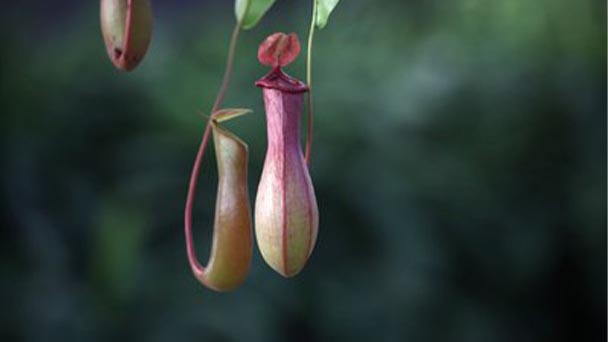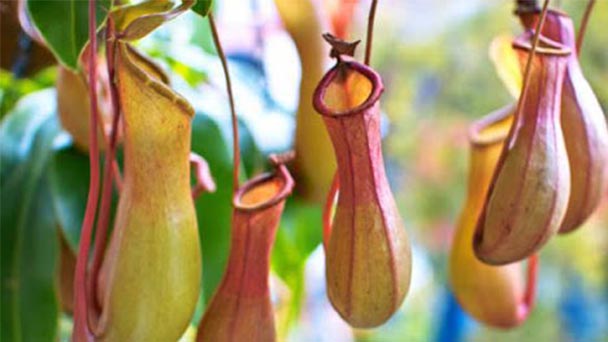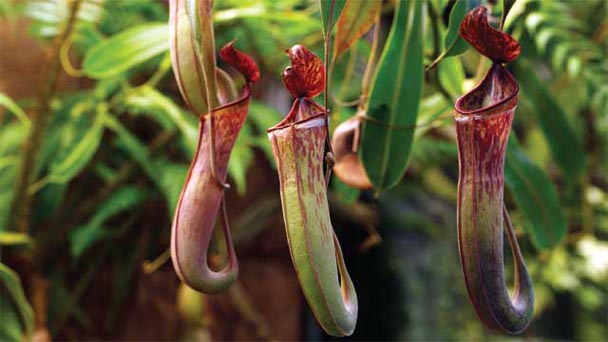Pitcher plant Profile
Written by Joy
Sep 27 2020

The pitcher plant is the general name for all species of the genus Pitcher. A tropical insectivorous plant, native mainly to the tropics of the Old World. It has a unique nutrient-absorbing organ-the insect cage, the worm cage is cylindrical, the lower half is slightly expanded, the cage has a lid on the mouth, because of its shape like a pig cage. The tail of the tendril is enlarged and unrolled to form a bottle, which can eat insects.


Pitcher plant morphological characteristics
Pitcher plants are perennial vines with woody or semi-woody stems more than 3 meters high and grow on trees or along the ground. Leaves are generally long oval, the end of the cage tendrils, so as to facilitate climbing. A bottle-shaped or funnel-shaped trap with a lid forms at the end of the caged vine. Pitcher plants do not bloom until many years after growth. The flowers are generally racemes, a few panicles, dioecious, flowers are small and bland, light taste in the daytime, slightly fragrant. At night, it smells strong and stinks. They are not as ornamental as a trap. Fruit is a capsule, when ripe dehiscent disperses seed.Pitcher plant growth habit and growing environment and distribution
Most pitcher plants live in environments with high humidity and temperature and bright scattered light. The edge or open space of a forest or shrub still could live. A few species, such as the apple pitcher plant, prefer to grow in dense, dark forests. Most species are adapted to live in grass populations similar to prairie species. Pitcher plants grow in acidic, nutrient-poor soils, but there are exceptions, such as the Malayan pitcher plant, which grows well in soils with a high metal content. Some pitcher plants also grow on rock walls. At the same time, some may even be attached to trees as epiphytes without touching the soil.Pitcher plants are mainly distributed in southeast Asia, of which Borneo (also known as Kalimantan Island) and Sumatra (the island belonging to Indonesia) are the most abundant, with about 40 species each, followed by the Philippines with about 30 species, Malay Peninsula with more than 10 species, and New Guinea and Sulawesi with about 20 species. There is also a species of pitcher plant in Guangdong, Guangxi, Hainan and Taiwan in southern China, which is also the most widely distributed pitcher plant, from southern China through southeast Asia to northern Australia.
Pitcher plant efficacy and role
The original plant of Lei Gong pot in Chinese herbal medicine is a strange pitcher plant in the genus Nepenthes, which is beneficial to clear lungs, moisten dryness, and detoxify. For dry cough, pertussis, jaundice, stomachache, dysentery, edema, abscess, insect bite.Pitcher plant cultivation
Because the seeds of pitcher plants are very small, it is best to use a culture substrate with fine particles such as peat to prevent the seeds from falling into the cracks. In order to evenly distribute the seeds on the substrate during sowing, the seeds can be mixed with a small amount of sand and then sprinkled on the substrate. The substrate must be kept moist. and it also requires high air humidity, so cover the mouth with plastic wrap and poke holes in it. Pitcher seeds need light to germinate, so keeping them in a bright place helps. But do not let the sun shine directly, or the high heat caused by the bright light will kill the seedlings.Latest Updated
- Benefits of Bugleweed - 7 Science-backed Health Benefits
- Bugleweed Dangers & Side Effects - Is It Poisonous?
- How to Plant Evergreen Trees - What You Should Know
- When to Plant Evergreens - Grow Guide for Evergreen Trees
- 12 Wonderful Evergreen Shrubs for Your Garden
- 12 Popular Evergreen Plants with Pictures for Beginners
- When And How To Prune A Lilac Bush Like a Pro
- How to Grow & Care for Lilac Vine (Hardenbergia Violacea)
- Japanese Lilac Tree (Syringa Reticulata) Care & Propagation Guide
- Shumard Oak Pros and Cons - What to Know
Popular Articles
- Winter maintenance of Antirrhinum Majus
- How to Grow Terminalia Mantaly Tree
- How to Grow and Care for Crossostephium Chinense
- How to grow Antirrhinum Majus in spring
- Peristeria Elata (Dove Orchid) Profile: Info & Care Guide
- Underwatered Snake Plant (Sansevieria Trifasciata) - Signs And How To Fix
- How to Care for Brazilian Jasmine Plant (Mandevilla Sanderi)
- How to Grow & Care for Graptopetalum Purple Delight in Summer
- Rosa Chinensis (China Rose): Plant Growing & Care Tips
- How to Care for Baby Sun Rose (Aptenia Cordifolia)